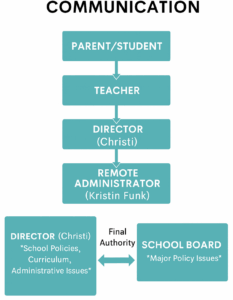Chain of Communication
Compassionate & Clear Communication
At Syringa Mountain School, we believe in compassionate, clear, and transparent communication. Strong communication builds trust, creates caring relationships, and supports a positive learning environment for all students.
When an issue arises, we encourage families to follow our Chain of Communication:
-
Teacher/Staff – The first step is always to connect directly with your child’s teacher or the staff member closest to the situation.
-
Director (Christi) – If the concern remains, please reach out to the Director for support.
-
Remote Administrator (Kristin Funk) – If further resolution is needed, the concern may be brought to our Remote Administrator.
-
School Board – The board’s role is governance and policy. Issues should only reach this step if they cannot be resolved through the previous levels or are related to larger policy matters.
We know that good communication doesn’t always mean everyone agrees, but it does mean everyone is heard. By following this process, we ensure that concerns are addressed respectfully and effectively, while maintaining a healthy, supportive school community.

